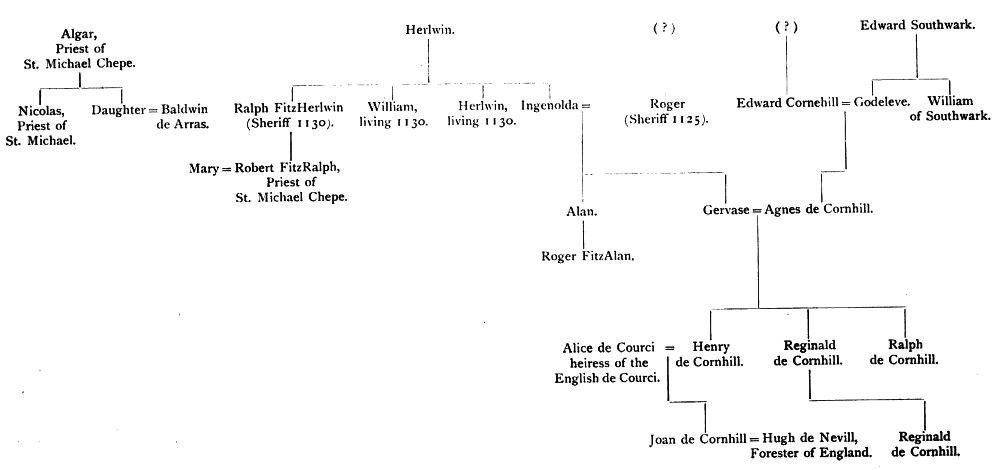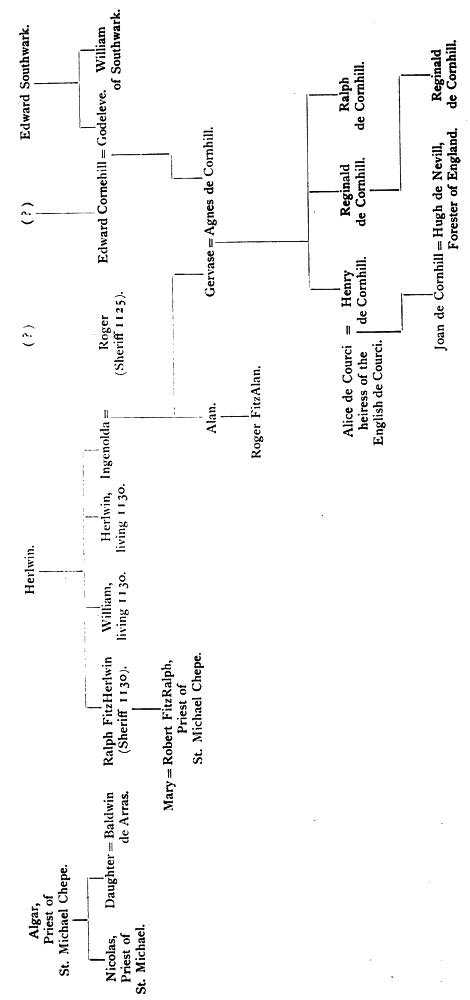

Search london history from Roman times to modern day
345
A NORMAN FAMILYIn Appendix K to Geoffrey de Mandeville, Mr. J. H. Round presents a little group, belonging to this period, of three families, together with a collection of facts and figures which, despite their scantiness, enable us to obtain more than a glimpse of the London Baron; the owner of manors and socs within and without the City; the merchant and the banker; the servant and the officer of the King; the Saxon who was also the companion and equal of the Norman nobles. “Few discoveries,” says Mr. Round, “in the course of these researches have afforded me more satisfaction and pleasure” than the investigation into the origin of Gervase de Cornhill, which led to the recovery of this group of the Norman period. It is difficult to imagine greater satisfaction for one who burrows among the documents of the past than thus to chance upon a chain of facts which bring to light a whole family, with its history, at the time when the Normans and the English were beginning to intermarry, shortly before the time when it was said—
“Jam cohabitantibus Anglicis et Normannis, et alterutrum uxores ducentibus vel nubentibus, sic permixtae sunt nationes, ut vix discerni possit hodie, de liberis loquor, quis Anglicus, quis Normannus sit genere.”
The most important of these families is that descended from one Herlwin, who, since his son was sheriff in 1130 when he was certainly not a very young man, was probably born before the Conquest. Since his name is simply stated without the Norman addition showing his parentage, we may gather that the Saxons after the Conquest retained the usage of giving the name without such qualification. Concerning Herlwin, Mr. Round tells us nothing except that he had at least three sons and one daughter. One of the sons, Ralph FitzHerlwin, was sheriff in 1130. The daughter, Ingenolda, married Roger, “nephew of Hubert.” Ralph FitzHerlwin’s son Robert married Mary, niece of Nicolas, priest of St. Michael Chepe. Nicolas himself was the son of Algar, priest of the same church. This priest Algar held the living on lease from St. Paul’s; his son succeeded him, and presented in his turn the living to his nephew by marriage, Robert FitzRalph, the grandson of Herlwin. We see, therefore, that priests married openly and blamelessly, and that they were able in some cases, as when they held a benefice, to bequeath, or to346 transfer it to their heirs. Probably Nicolas had no sons, or Robert FitzRalph would have had to look elsewhere for a living. It is also apparent that the parish priests were recruited from the governing class of the City, and that this class intermarried with the children of the clergy.
Roger, “nephew to Hubert,” was evidently a man of great consideration. He was chosen by the King in 1125 with Aubrey de Vere to invest the House of the Holy Trinity with the Portsoken when the Cnihten Gild handed it over to the monks. He was sheriff in the same year: he is mentioned in an earlier document as one of the “Barons of London,”—“Hugoni de Bocheland, Rogero, Leofstano, Ordgaro, et omnibus aliis baronibus Lundoniae.” Mr. Round has found two Royal Charters, one of which conveys to him the Manor of Chalk. Roger was one of the multitude who were affected by the great religious enthusiasm of the time: he must needs go on pilgrimage, and went to Jerusalem, dying on the way there or back, if he did not die in the Holy City itself. It will be remembered that another city magnate, Gilbert Becket, also went on pilgrimage to Jerusalem at the same time. The son Gervase was called De Cornhill, as the heir of his wife’s father, Edward de Cornhill or Hupcornhill. Mr. Round notes, on the form Hupcornhill, similar forms at Colchester, as “Opethewalle” and “Hoppeoverhumber,” i.e. the man who came “up from beyond the Humber.” He was sheriff in 1155, and is mentioned as Justiciar of London in the only Charter left of those granted by Stephen’s Queen, “Sciatis quod dedi Gervasio Justicianis de Londonia X marcetas terrae.”
This Gervase of Cornhill or Gervase FitzRoger was one of the most prominent of the London citizens during the reigns of Stephen and Henry II. He was born about the year 1110 and he died about the year 1183. He was a landowner in the City and in the country. The Manor of Chalk, which had been granted to his father, Roger, was afterwards granted to him. In the records of the Duchy of Lancaster (1123-1136) is a grant of land in “Eadintune” by William Archbishop of Canterbury to Gervase and Agnes his wife. Agnes is described as the daughter of Edward of Cornhill and Godeleve his wife. The name of Gervase occurs twice under Stephen and “innumerable times” (Round) under Henry II., both in a public and a private capacity. Gervase was not only a merchant: like all successful merchants of the time he advanced money on mortgage and obtained lands by foreclosing.
The strange history of the Cnihten Gild and its dissolution has already been told. The light of reality is thrown upon this event when we read that Edward of Cornhill was one of the Gild; that Edward of Southwark, the father of Godeleve, and William of Southwark her brother, were witnesses of the deed conveying Portsoken to the Holy Trinity Priory, as well as Roger, Gervase’s father.
Turn again to Gervase of Cornhill. His son Henry, Sheriff of London, Kent, and Surrey, married Alice, a daughter and heiress of the English branch of the De347 Courceys. She afterwards married Warin FitzGerald. The daughter of Henry and Alice, Joan de Cornhill, married Hugh de Neville, Forester of England. I think that nothing, so far discovered, better illustrates the position of the London merchants than this genealogy and these facts, rescued by a laborious antiquary from the scanty records of the time. We see the Barons of London on an equality with the Norman aristocracy, acting with them, and intermarrying with them; acquiring lands in the country; going on pilgrimage to the Holy Land; becoming the principal actors in that most remarkable event,—the Dissolution of the venerable Saxon Gild and the transfer of the property which they held in trust to a Religious House. We see a merchant of London holding the post of Justiciar. I wish it had been possible for Mr. Round to have carried his researches further into the annals of this family. One knows not where their descendants might be found at the present day.
One more episode in the history of Gervase has been unearthed by Mr. Round (Feudal England, p. 471).
The manor of Langham in Essex, near Colchester, was part of the property of the great Clare family. It was given by Richard de Clare, some time before the year 1086, to Walter Tirel, who married his daughter Adeliza. Sometime between 1138 and 1148, Hugh Tirel sold the manor, or raised money upon it, the purchaser, or the lender, being Gervase of Cornhill, who obtained possession of it either by foreclosing the mortgage or by purchase, Hugh Tirel himself taking a part in the Crusade, while the London merchant, staying at home, profited by the religious enthusiasm of the time. Fifty years later, Richard I. granted permission to Henry, son of Gervase of Cornhill, to enclose and impark his woods at Langham. “Thus,” says Round, “did the wealthy Londoner become a country squire some centuries ago.” (See Appendix V.)
348


A tabular representation of the tree is shown here.
Trying to avoid privacy and cookie settings overwriting content